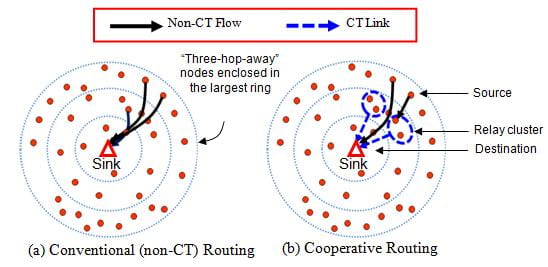![]()
This project is supported by the National Science Foundation under grant CNS-1017984.
The range extension from CT discussed above can solve an energy balancing problem in battery-driven multi-hop wireless sensor networks (WSNs). A WSN includes a large number of low-cost, severely energy constrained sensor nodes, spread out over the area being sensed, and typically one expensive Sink node, which is not so energy constrained and serves as the interface between the sensors and the internet. The nodes in a WSN measure various parameters or make detections, and report the information to the Sink. Because of their energy constraint, the sensor nodes can transmit only over a short range, and therefore, the nodes whose transmissions can reach the Sink directly (defined as “one-hop away nodes”) must relay the packets from other nodes whose transmissions cannot directly reach the Sink.

(a) shows a WSN that does not do CT, with the Sink in the center; the light blue dotted circles partition the nodes into “one-hop-away,” “two-hop-away,” and “three-hop-away” rings. The so-called “energy hole problem” is that the one-hop-away nodes run out of battery energy first because they have to forward packets from the rest of the network. SARL has created a new forwarding scheme that uses CT to spare the nodes near the Sink from having to relay all the packets of the network. For example, in (b), the bold blue dashed curves indicate a relay cluster in the basic CT topology that can reach the Sink directly. The CT is triggered at just the right times to balance the energy consumption across the network, thereby extending network life by factors of five and higher, compared to the popular energy-aware non-CT routing protocol CMAX.
In theory, CCT or MAC-aided CT (i.e. when only one cooperating node transmits at a time) can be used with this forwarding technique. The preliminary results for this forwarding scheme are based on generic CT gains, under the assumption of perfect time synchronization. However, CCT may be preferred because its synchronization approach works well for range extension.
Related Publications
- Jin Woo Jung and Mary Ann Ingram, “Using range extension cooperative transmission in energy harvesting wireless sensor networks,” Journal of Communications and Networks, vol.14, no.2, pp.169,178, April 2012. View PDF (1286 KB)
- Jin Woo Jung and Mary Ann Weitnauer, “On Using Cooperative Routing for Lifetime Optimization of Multi-Hop Wireless Sensor Networks: Analysis and Guidelines,” IEEE Transactions on Communications, no. 99, pp.1-11, 2013. View PDF (576 KB)
- Jin Woo Jung and Mary Ann Ingram, “Residual-Energy-Activated Cooperative Transmission (REACT) to Avoid the Energy Hole,” to be presented at the IEEE International Conference on Communications (ICC) Workshop on Cooperative and Cognitive Mobile Networks (CoCoNet3), June 2010. View PDF 164 KB
- Jin Woo Jung, Wensi Wang, and Mary Ann Ingram, “Cooperative Transmission Range Extension for Duty Cycle-Limited Wireless Sensor Networks,” 2nd International Conference on Wireless Communications, Vehicular Technology, Information Theory and Aerospace and Electronic Systems (Wireless VITAE), Chennai, India, 28 Feb – 3 March, 2011. View PDF (222 KB)
- Jin Woo Jung and M.A. Ingram, “Lifetime Optimization of Multi-hop Wireless Sensor Networks by Regulating the Frequency of Use of Cooperative Transmission,” Military Communications Conference (MILCOM), Baltimore, MD, November, 2011. View PDF (324 KB)
- Jin Woo Jung and Mary Ann Ingram, “On the Optimal Lifetime of Cooperative Routing for Multi-hop Wireless Sensor Networks,” IEEE Wireless Communications and Networking Conference (WCNC 2013), Shanghai, China, April, 2013. View PDF (324 KB)
Last revised on September 15, 2013.

